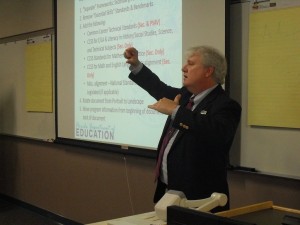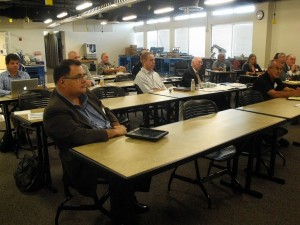for manufacturing, transportation, distribution & logistics, and engineering & technology education at the Florida Department of Education says machinists need a strong foundation of knowledge in mathematics, 3D modeling, metallurgy, and computer programming. To get a deeper look into the issue, one has to look at the courses and curriculum framework that forms the foundations in building these skills set. As in most cases, “any good occupational technical curriculum should start with a well thought out functional job analysis that matches industry needs” said Jerry Lancio. Both Lancio and Norman were presenters at the one day machining workshop hosted by FLATE.
program in Florida, and learned about new requirements/changes for the 2014-15 school year. “My aim is to provide a good understanding of the frameworks” that will enable educators to create a solid curriculum pathway for students who are graduating from high school and going to college said Norman. Workshop participants also learned about the DACUM (Developing a Curriculum) process that starts with a functional job analysis, crosses over to mapping learning outcomes of courses and course sequence, and finally building a master curriculum outline. “I hope business and industry can see how curriculum framework process works, and educators can also see how curriculum can be built to meet industry needs” Norman said.
aligned to national standards and an overview of the NIMS certification which is a nationally recognized, portable, NAM-endorsed certification which works and plays well with other industry certifications in creating a logical path. “What I learned at the workshop will help in my current job because it has given me a better idea of how to align curriculum with credential requirements, and what resources are available to me” said Flansburg.
For more information on the machining workshop visit www.fl-ate.organd www.madeinflorida.org, or email Dr. Marilyn Barger at barger@fl-ate.org.
Terms of Use | Privacy Statement
Copyright © 2024 All Rights Reserved


























